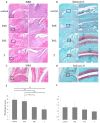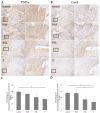Treadmill Running in Established Phase Arthritis Inhibits Joint Destruction in Rat Rheumatoid Arthritis Models
- PMID: 31618828
- PMCID: PMC6834114
- DOI: 10.3390/ijms20205100
Treadmill Running in Established Phase Arthritis Inhibits Joint Destruction in Rat Rheumatoid Arthritis Models
Abstract
Exercise therapy inhibits joint destruction by suppressing pro-inflammatory cytokines. The efficacy of pharmacotherapy for rheumatoid arthritis differs depending on the phase of the disease, but that of exercise therapy for each phase is unknown. We assessed the differences in the efficacy of treadmill running on rheumatoid arthritis at various phases, using rat rheumatoid arthritis models. Rats with collagen-induced arthritis were used as rheumatoid arthritis models, and the phase after immunization was divided as pre-arthritis and established phases. Histologically, the groups with forced treadmill running in the established phase had significantly inhibited joint destruction compared with the other groups. The group with forced treadmill running in only the established phase had significantly better bone morphometry and reduced expression of connexin 43 and tumor necrosis factor α in the synovial membranes compared with the no treadmill group. Furthermore, few cells were positive for cathepsin K immunostaining in the groups with forced treadmill running in the established phase. Our results suggest that the efficacy of exercise therapy may differ depending on rheumatoid arthritis disease activity. Active exercise during phases of decreased disease activity may effectively inhibit arthritis and joint destruction.
Keywords: articular cartilage; autoimmune disorder; collagen-induced arthritis; connexin 43; exercise; exercise therapy; osteoporosis; pro-inflammatory cytokine; rheumatoid arthritis; treadmill running.
Conflict of interest statement
The authors declare no conflict of interest.
Figures






References
-
- Nanki T., Hayashida K., El-Gabalawy H.S., Suson S., Shi K., Girschick H.J., Yavuz S., Lipsky P.E. Stromal cell-derived factor-1-CXC chemokine receptor 4 interactions play a central role in CD4+ T cell accumulation in rheumatoid arthritis synovium. J. Immunol. 2000;165:6590–6598. doi: 10.4049/jimmunol.165.11.6590. - DOI - PubMed
-
- Aletaha D., Neogi T., Silman A.J., Funovits J., Felson D.T., Bingham C.O., Birnbaum N.S., Burmester G.R., Bykerk V.P., Cohen M.D., et al. Rheumatoid arthritis classification criteria: An American College of Rheumatology/European League Against Rheumatism collaborative initiative. Arthritis Rheum. 2010;62:2569–2581. doi: 10.1002/art.27584. - DOI - PubMed
-
- Maini R., St Clair E.W., Breedveld F., Furst D., Kalden J., Weisman M., Smolen J., Emery P., Harriman G., Feldmann M., et al. Infliximab (chimeric anti-tumour necrosis factor α monoclonal antibody) versus placebo in rheumatoid arthritis patients receiving concomitant methotrexate: A randomised phase III trial. Lancet. 1999;354:1932–1939. doi: 10.1016/S0140-6736(99)05246-0. - DOI - PubMed
MeSH terms
Substances
Grants and funding
LinkOut - more resources
Full Text Sources
Medical

